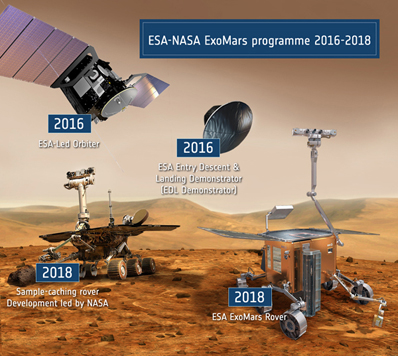



|

|

Destination: Mars for
ESA and NASA
KEITH COOPER
ASTRONOMY NOW
Posted: December 23, 2009


A joint venture between NASA and the European Space Agency (ESA) will see three new missions blast off to Mars in 2016 and 2018 respectively, to investigate methane and other trace gases in the Martian atmosphere and to explore the surface.
 ESA and NASA’s plans for the future of Mars exploration. Image: ESA. ESA and NASA’s plans for the future of Mars exploration. Image: ESA.
The new missions, which will be led by ESA, initially to the tune of 850 million euros, will develop the ExoMars rover mission that has been in the planning stages over the last few years. First up will be the tentatively named ExoMars Trace Gas Orbiter, to launch in six years. As the name suggests, it will scan Mars’ atmosphere for trace gases such as methane, which in recent years has been discovered in the Martian atmosphere in anomalous amounts. Although its scientific payload has yet to be decided upon (instruments will be built by both NASA and ESA), tentative plans describe how the orbiter will image the surface in high-resolution (one to two metres per pixel) for signs of where these gases may be emitted, and also monitor the weather, both globally and regionally, with wide-angle cameras that will scan from horizon to horizon. One instrument in particular that may find its way onto the mission would be a ‘Solar Occultation Fourier Transform Infrared Spectrometer’. This would survey the atmospheric composition by measuring how sunlight is absorbed by different gases through a large tract of the atmosphere as the Sun passes behind Mars.
The orbiter will also carry a small entry–descent–landing (EDL) demonstration vehicle in preparation for the two rovers, including Europe’s ExoMars rover, that are planned to set off for Mars in 2018. ExoMars will be redesigned to be significantly larger than the initial concepts that had a drill that would tunnel two metres into the Martian regolith to search for signs of life, either past or present. On the other side of the pond NASA will build a rover that will analyse samples of regolith and rock that it comes across on its travels, a bit like a mobile version of the Phoenix lander that touched down in the north polar region of Mars in 2008.
“This marks an important moment for Europe in its steps towards space exploration on the world scale,” says Professor David Southwood, the Director of Science and Robotic Exploration at ESA. “We have been to the planets before, sure, but now we have a plan for exploration to build our technical capability and explore Mars in a long-term partnership.
|

|

|

|
|



